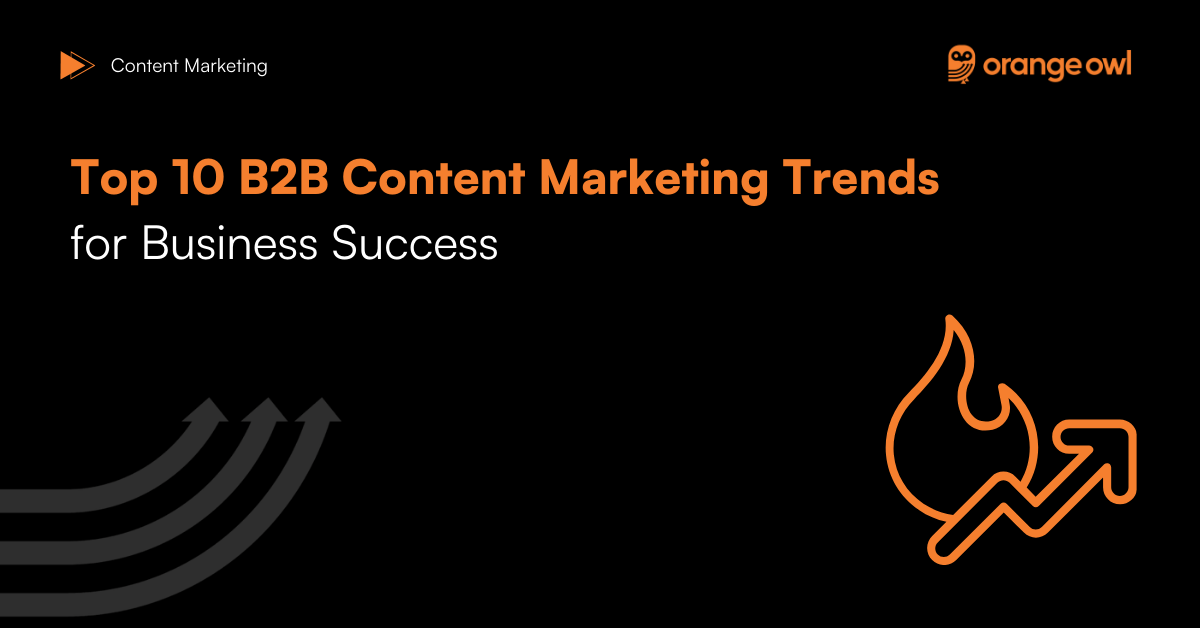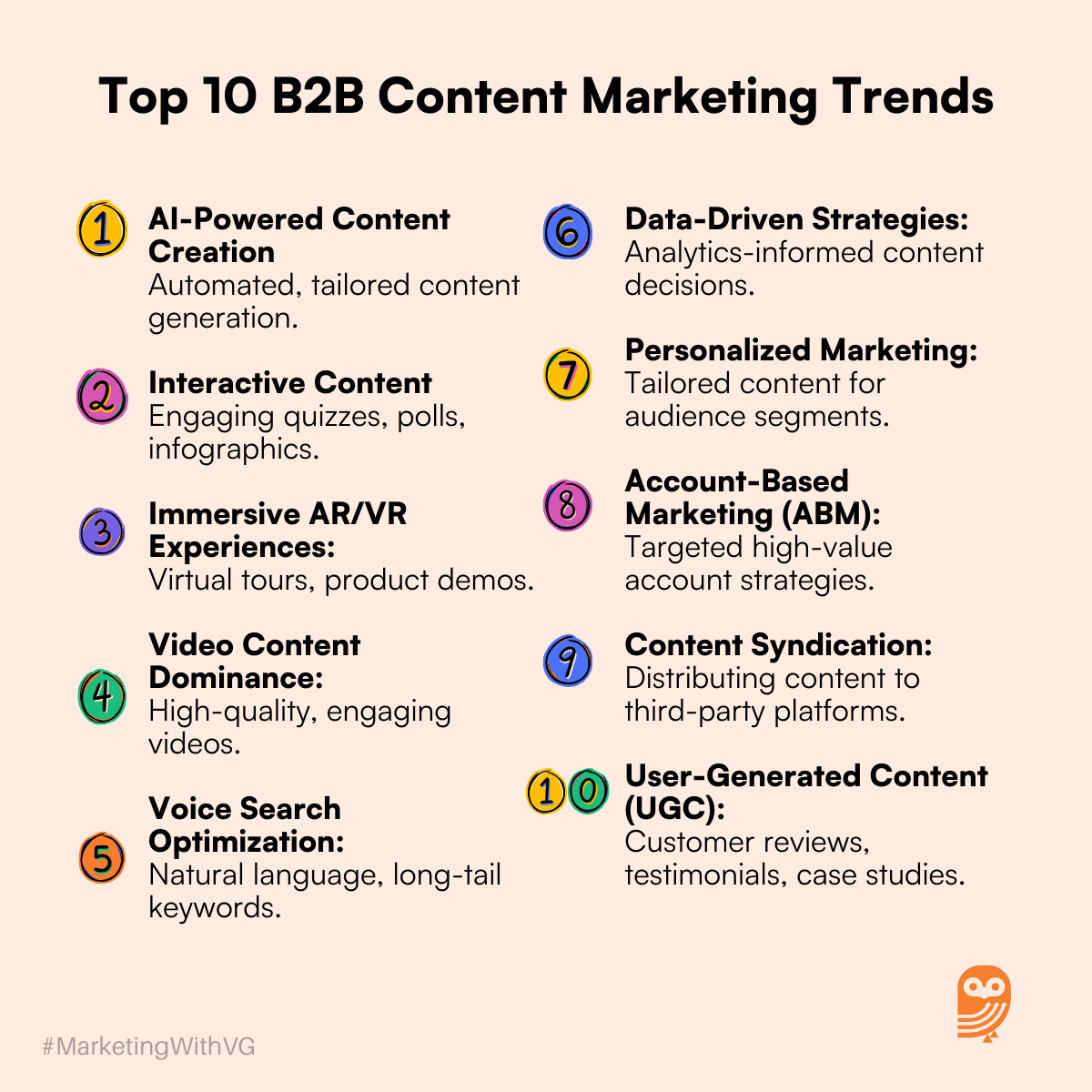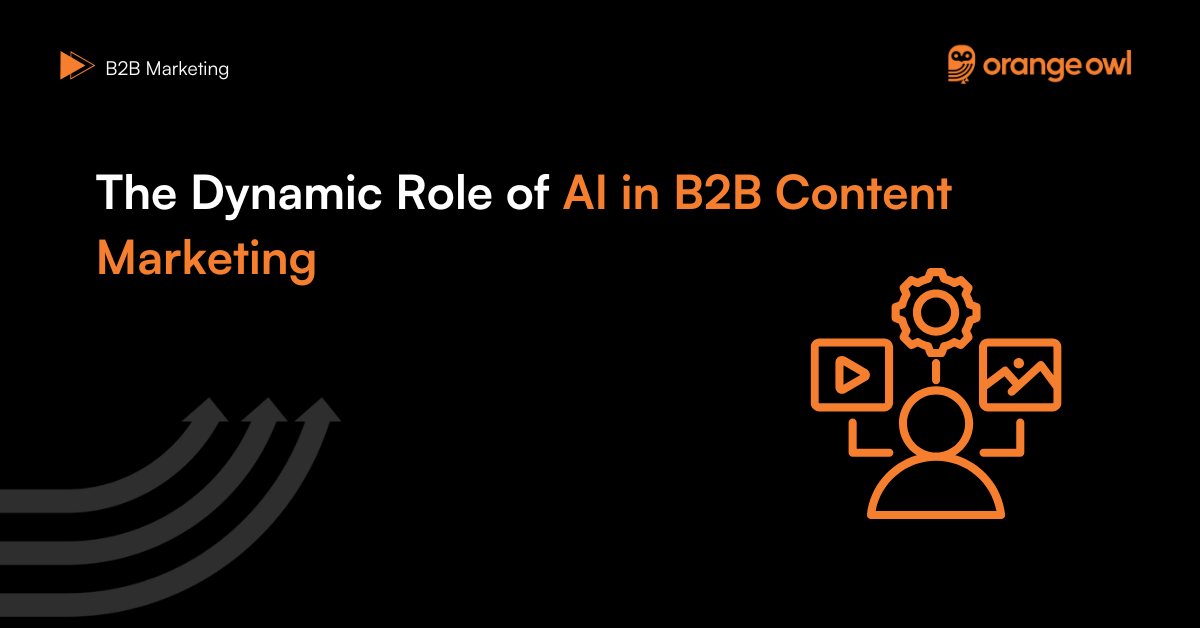Top 10 B2B Content Marketing Trends for Business Success in 2025
Vivek Goel
January 28, 2025

Table of Contents
In the dynamic world of B2B marketing, staying ahead of trends is crucial for maintaining a competitive edge and driving business success. As we approach 2025, several emerging trends are set to reshape the landscape of B2B content marketing. This blog explores the top 10 B2B content marketing trends that will help businesses thrive in the coming year.

1. AI-Powered Content Creation and Optimization
The Rise of AI in Content Marketing
Topping the chart of the top B2B Content Marketing trends is the Rise of AI. Artificial Intelligence (AI) is transforming the way content is created, optimized, and personalized. AI-powered tools can analyze vast amounts of data to generate content ideas, write articles, and even optimize existing content for better performance. This technology allows marketers to create high-quality content at scale, tailored to specific audience segments.
How to Leverage AI for Content Marketing
- Content Generation: Use AI tools like Jasper and Copy.ai to generate blog posts, social media updates, and other content quickly and efficiently.
- Content Optimization: Implement AI tools such as MarketMuse to analyze content performance and provide actionable insights for optimization.
- Personalization: Utilize AI to personalize content for different audience segments, enhancing engagement and conversion rates.
Example
A technology company used AI to create personalized email campaigns, resulting in a 20% increase in open rates and a 15% boost in conversions.
2. Interactive and Immersive Content
Engaging Audiences with Interactive Content
Interactive content, such as quizzes, polls, and interactive infographics, engages users more effectively than static content. It encourages active participation, leading to higher engagement rates and better retention of information.
Immersive Experiences with AR/VR
Augmented Reality (AR) and Virtual Reality (VR) are becoming increasingly popular in B2B marketing. These technologies provide immersive experiences that can showcase products, offer virtual tours, and create interactive training modules.
How to Implement Interactive and Immersive Content
- Interactive Elements: Incorporate quizzes, calculators, and interactive infographics into your content strategy to engage users.
- AR/VR Experiences: Use platforms like Ceros to create interactive content and Zappar for AR experiences.
- Virtual Tours: Offer virtual tours of your facilities or product demonstrations using VR to provide an immersive experience.
Example
A manufacturing company used VR to offer virtual tours of their factory, providing potential clients with an in-depth understanding of their processes and capabilities, leading to a 25% increase in lead generation.
3. Video Content Dominance
The Growing Importance of Video
Video continues to dominate as one of the most engaging and effective content formats. With the rise of platforms like YouTube, LinkedIn, and TikTok, video content has become essential for reaching and engaging B2B audiences. You cannot and must not miss this trend for B2B Content Marketing.
Types of Video Content
- Explainer Videos: Simplify complex concepts and showcase products or services.
- Webinars: Provide in-depth knowledge and engage with your audience in real time.
- Customer Testimonials: Build trust by sharing customer success stories.
- Product Demos: Demonstrate the features and benefits of your products.
How to Leverage Video Content
- Create High-Quality Videos: Invest in professional video production to ensure your content is polished and engaging.
- Use Video Analytics: Utilize platforms like Wistia and Vimeo to track video performance and optimize content.
- Live Streaming: Engage with your audience in real-time through live webinars and Q&A sessions on platforms like LinkedIn Live.
Example
A software company increased its product adoption rates by 30% through a series of high-quality explainer videos that demonstrated the features and benefits of its software.
4. Voice Search Optimization
The Impact of Voice Search
With the proliferation of smart speakers and voice-activated assistants, optimizing content for voice search is becoming increasingly important. Voice search queries are typically longer and more conversational than text searches, requiring a different approach to SEO.
How to Optimize for Voice Search
- Use Natural Language: Write content in a conversational tone that matches the way people speak.
- Long-Tail Keywords: Focus on long-tail keywords and phrases that are more likely to be used in voice searches.
- Answer Questions: Create content that directly answers common questions related to your industry.
Example
A financial services firm optimized its content for voice search, leading to a 40% increase in organic traffic from voice search queries.
5. Data-Driven Content Strategies
Leveraging Data for Content Marketing
Data analytics play a crucial role in shaping content strategies. By analyzing data on audience behaviour, content performance, and market trends, businesses can create more targeted and effective content.
Tools for Data-Driven Content
- Google Analytics: Track website traffic, user behaviour, and conversion rates.
- HubSpot: Combine content performance tracking with lead management and CRM integration.
- Tableau: Visualize data to gain deeper insights into content performance and audience engagement.
How to Implement Data-Driven Content Strategies
- Analyze Audience Behavior: Use data to understand what content resonates with your audience and tailor your strategy accordingly.
- Track Performance: Regularly monitor content performance metrics to identify what’s working and what needs improvement.
- Refine Strategy: Continuously refine your content strategy based on data insights to maximize ROI.
Example
A B2B marketing agency used data analytics to identify high-performing content topics, resulting in a 50% increase in engagement rates.
6. Personalized Content Marketing
The Power of Personalization
Personalized content marketing involves tailoring content to meet the specific needs and preferences of individual audience segments. This approach can significantly enhance engagement and conversion rates.
How to Personalize Content
- Segment Your Audience: Divide your audience into segments based on criteria such as industry, company size, and behavior.
- Tailor Content: Create personalized content for each segment to address their unique needs and challenges.
- Use Personalization Tools: Implement tools like Dynamic Yield and Segment to automate content personalization.
Example
A SaaS company increased its email open rates by 35% by personalizing email content based on user behaviour and preferences.
7. Account-Based Marketing (ABM)
The Shift to ABM
Account-Based Marketing (ABM) is a strategic approach that focuses on targeting high-value accounts with personalized marketing efforts. ABM can lead to higher ROI by aligning marketing and sales efforts to engage specific target accounts.
How to Implement ABM
- Identify Target Accounts: Use data and insights to identify high-value target accounts.
- Personalize Content: Create tailored content and campaigns for each target account.
- Align Sales and Marketing: Ensure close collaboration between sales and marketing teams to deliver a cohesive ABM strategy.
Example
A cybersecurity company implemented an ABM strategy, leading to a 40% increase in deal size and a 20% reduction in sales cycle length.
8. Content Syndication
Expanding Reach with Content Syndication
Content syndication involves distributing your content to third-party platforms to reach a broader audience. This strategy can significantly increase content visibility and drive traffic to your website.
How to Leverage Content Syndication
- Choose the Right Platforms: Identify platforms that reach your target audience, such as industry blogs, online magazines, and content networks.
- Create High-Quality Content: Ensure your content is valuable and relevant to the audience of the syndication platform.
- Track Performance: Use analytics to track the performance of syndicated content and optimize your strategy.
Example
A B2B software company syndicated its blog content on industry websites, resulting in a 25% increase in website traffic and a 15% boost in lead generation.
9. User-Generated Content (UGC)
The Value of User-Generated Content
User-generated content (UGC) includes reviews, testimonials, case studies, and social media posts created by your customers. UGC adds authenticity and credibility to your brand and can influence purchasing decisions.
How to Encourage UGC
- Create Opportunities for Engagement: Encourage customers to share their experiences through reviews, testimonials, and social media posts.
- Showcase UGC: Highlight user-generated content on your website, social media, and marketing materials.
- Engage with Your Audience: Respond to UGC and engage with your audience to build a community around your brand.
Example
An enterprise software company featured customer testimonials and case studies on their website, increasing trust and credibility and leading to a 30% increase in conversion rates.
10. Sustainability and Social Responsibility
The Growing Importance of Sustainability
Sustainability and social responsibility are becoming increasingly important to B2B buyers. Companies that demonstrate a commitment to these values can enhance their brand reputation and attract more customers.
How to Incorporate sustainable content
- Highlight Sustainable Practices: Create content that showcases your company’s commitment to sustainability and social responsibility.
- Share Success Stories: Share case studies and success stories that highlight the positive impact of your sustainable practices.
- Engage with Your Audience: Encourage discussions around sustainability and social responsibility through blogs, social media, and webinars.
Example
A logistics company created a series of blog posts and videos highlighting their sustainable practices and partnerships, enhancing their brand reputation and attracting environmentally conscious clients.
Conclusion – B2B Content Marketing Trends
Staying ahead of the latest trends in B2B content marketing is crucial for business success in 2025. By leveraging AI-powered tools, creating interactive and immersive content, optimizing for voice search, and embracing personalized marketing and ABM strategies, businesses can enhance their content marketing efforts and drive significant growth. Additionally, focusing on sustainability and encouraging user-generated content can further strengthen your brand’s reputation and appeal. Embrace these trends and adapt your strategies to stay competitive in the ever-evolving B2B landscape.
Top 5 Frequently Asked Questions (FAQs) on B2B Content Marketing Trends
Small businesses can start with affordable AI tools like Grammarly for content optimization and Copy.ai for generating ideas and drafts. Additionally, free or low-cost versions of AI-powered tools like Google Analytics provide valuable insights for data-driven content strategies. These tools offer significant benefits without requiring a large investment.
To measure the ROI of interactive content, track metrics such as engagement rates, dwell time, and conversion rates. Use tools like Hotjar for heatmaps and user behavior analytics, and Google Tag Manager to track interactions with interactive elements. Additionally, monitor lead generation and customer feedback to assess the impact on your overall marketing goals.
To keep video content relevant and engaging, regularly update it to reflect industry trends and audience interests. Conduct audience research to understand their evolving needs and preferences. Use platforms like Vidyard for video analytics to track performance and gather insights. Incorporate feedback from viewers and continuously improve your content quality and messaging.
Integrate voice search optimization by focusing on natural language and conversational keywords. Create FAQ sections on your website to address common voice search queries. Use structured data markup to enhance search engine understanding of your content. Regularly update your content to include long-tail keywords that reflect how people speak in voice searches. Tools like AnswerThePublic can help identify popular voice search phrases.
To balance personalization with data privacy, ensure compliance with data protection regulations like GDPR and CCPA. Collect only necessary data and be transparent about its use. Implement robust data security measures and allow users to opt-in or opt-out of data collection. Use anonymized data for personalization when possible. Tools like OneTrust can help manage data privacy and compliance effectively.


